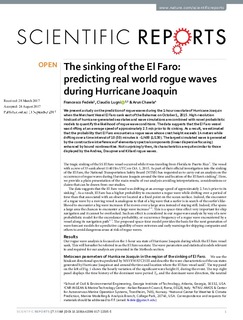| dc.contributor.author | Fedele, Francesco | |
| dc.contributor.author | Lugni, Claudio | |
| dc.contributor.author | Chawla, Arun | |
| dc.date.accessioned | 2017-10-02T06:45:04Z | |
| dc.date.available | 2017-10-02T06:45:04Z | |
| dc.date.created | 2017-09-30T12:50:01Z | |
| dc.date.issued | 2017 | |
| dc.identifier.citation | Scientific Reports. 2017, 7 (11188), . | nb_NO |
| dc.identifier.issn | 2045-2322 | |
| dc.identifier.uri | http://hdl.handle.net/11250/2457593 | |
| dc.description.abstract | We present a study on the prediction of rogue waves during the 1-hour sea state of Hurricane Joaquin when the Merchant Vessel El Faro sank east of the Bahamas on October 1, 2015. High-resolution hindcast of hurricane-generated sea states and wave simulations are combined with novel probabilistic models to quantify the likelihood of rogue wave conditions. The data suggests that the El Faro vessel was drifting at an average speed of approximately 2.5 m/s prior to its sinking. As a result, we estimated that the probability that El Faro encounters a rogue wave whose crest height exceeds 14 meters while drifting over a time interval of 10 (50) minutes is ~1/400 (1/130). The largest simulated wave is generated by the constructive interference of elementary spectral components (linear dispersive focusing) enhanced by bound nonlinearities. Not surprisingly then, its characteristics are quite similar to those displayed by the Andrea, Draupner and Killard rogue waves. | nb_NO |
| dc.language.iso | eng | nb_NO |
| dc.publisher | Nature Publishing Group | nb_NO |
| dc.rights | Navngivelse 4.0 Internasjonal | * |
| dc.rights.uri | http://creativecommons.org/licenses/by/4.0/deed.no | * |
| dc.title | The sinking of the El Faro: predicting real world rogue waves during Hurricane Joaquin | nb_NO |
| dc.type | Journal article | nb_NO |
| dc.type | Peer reviewed | nb_NO |
| dc.description.version | publishedVersion | nb_NO |
| dc.source.pagenumber | 15 | nb_NO |
| dc.source.volume | 7 | nb_NO |
| dc.source.journal | Scientific Reports | nb_NO |
| dc.source.issue | 11188 | nb_NO |
| dc.identifier.doi | 10.1038/s41598-017-11505-5 | |
| dc.identifier.cristin | 1500808 | |
| dc.description.localcode | his article is licensed under a Creative Commons Attribution 4.0 International License, which permits use, sharing, adaptation, distribution and reproduction in any medium or format, as long as you give appropriate credit to the original author(s) and the source, provide a link to the Creative Commons license, and indicate if changes were made. The images or other third party material in this article are included in the article’s Creative Commons license, unless indicated otherwise in a credit line to the material. If material is not included in the article’s Creative Commons license and your intended use is not permitted by statutory regulation or exceeds the permitted use, you will need to obtain permission directly from the copyright holder. To view a copy of this license, visit http://creativecommons.org/licenses/by/4.0/. | nb_NO |
| cristin.unitcode | 194,64,20,0 | |
| cristin.unitname | Institutt for marin teknikk | |
| cristin.ispublished | true | |
| cristin.fulltext | original | |
| cristin.qualitycode | 1 | |

